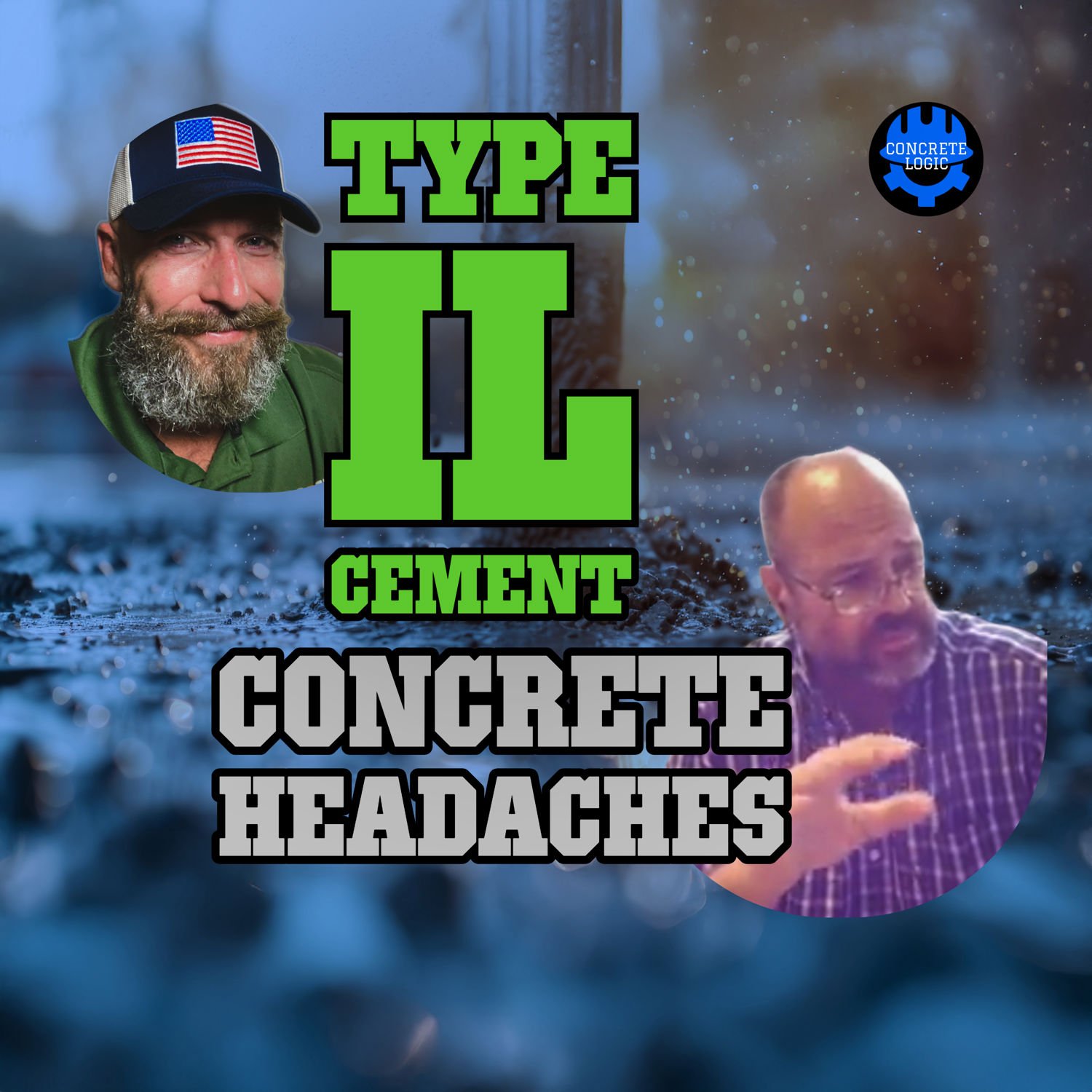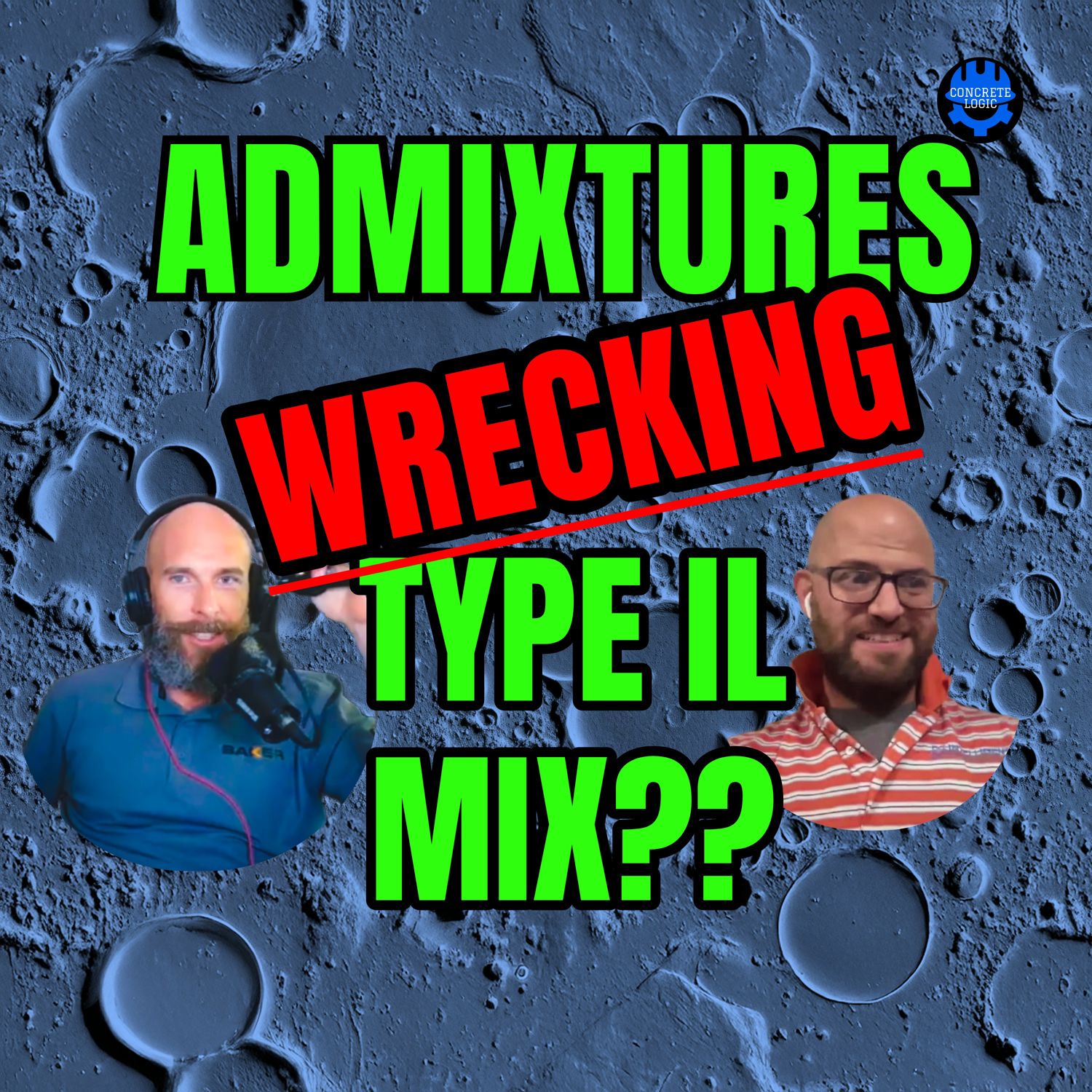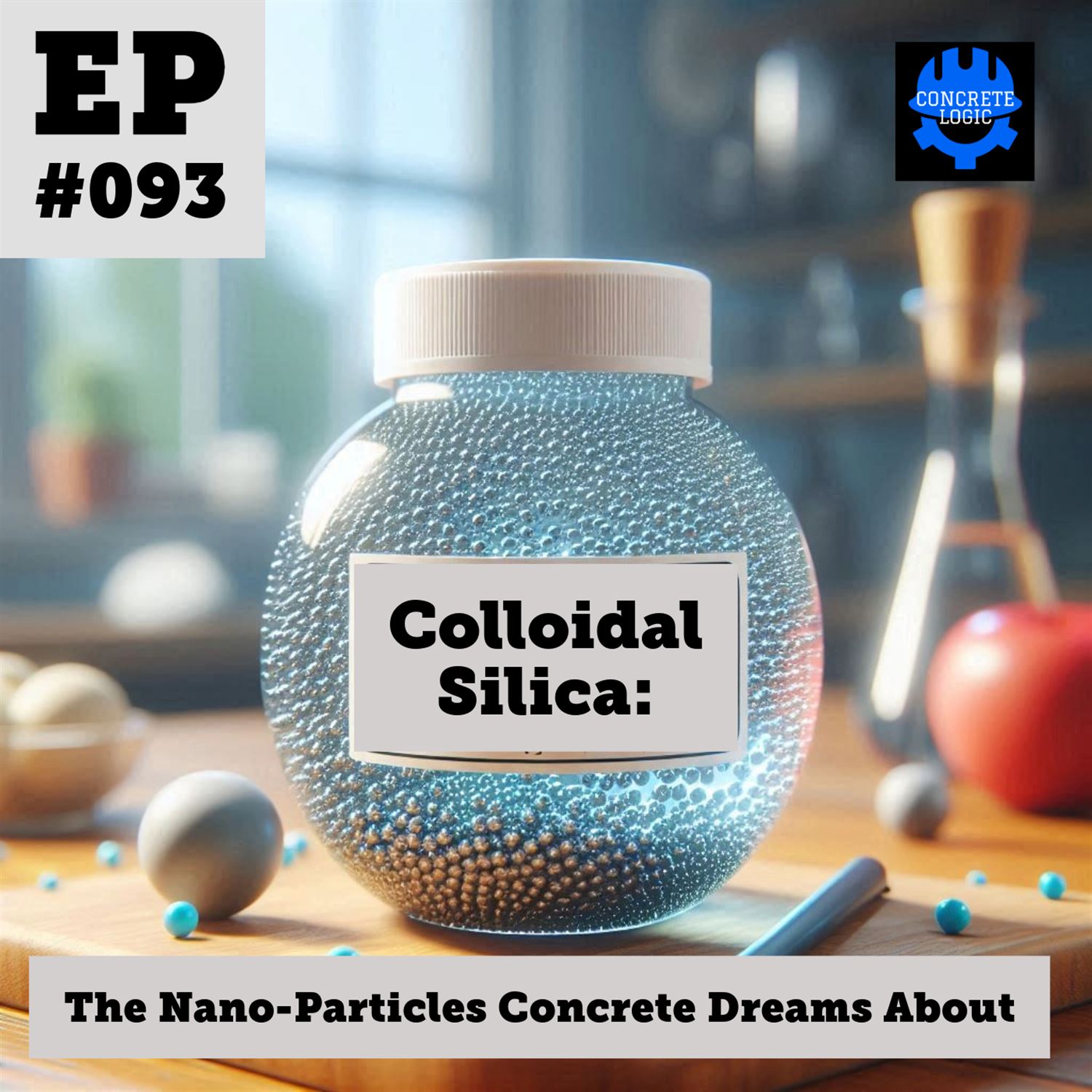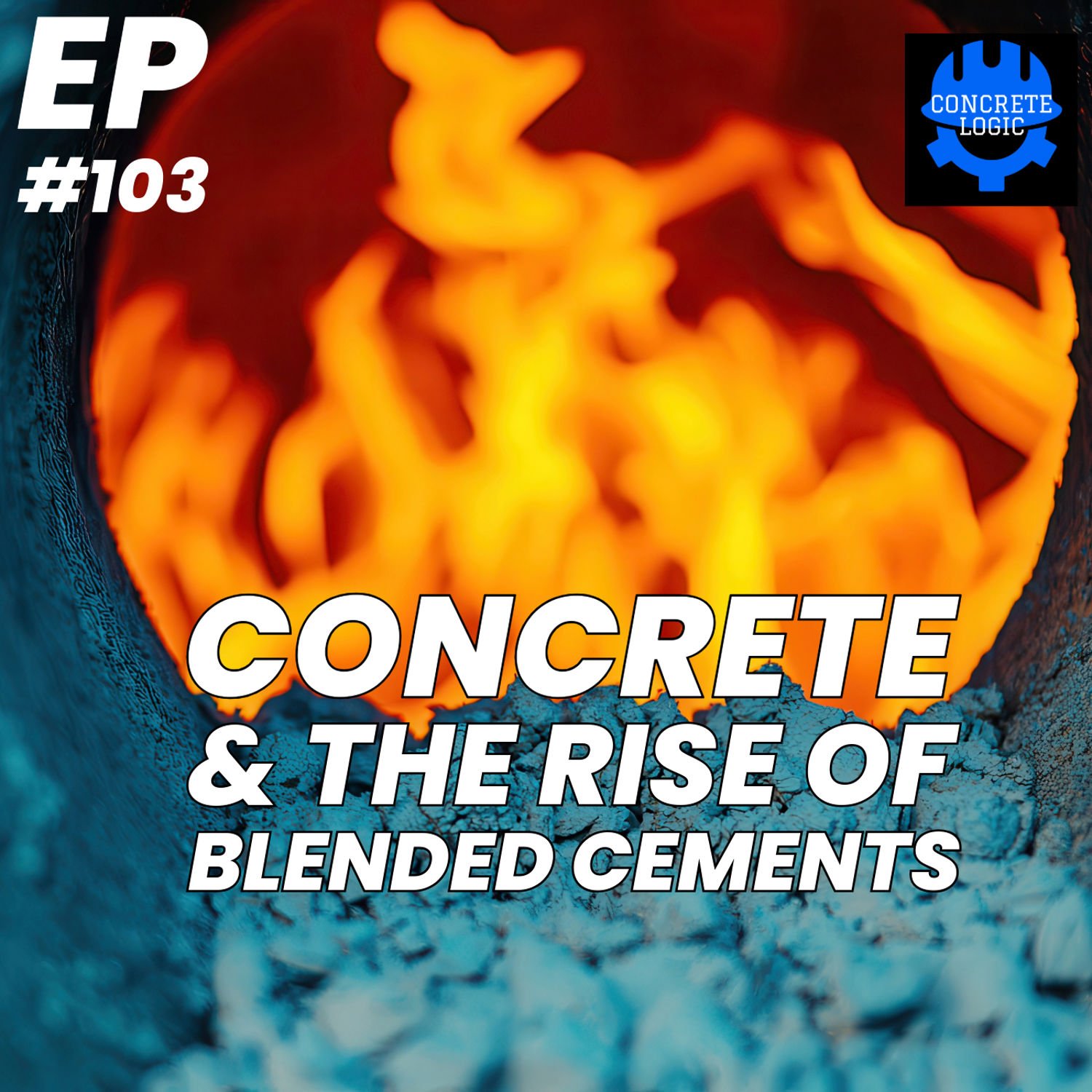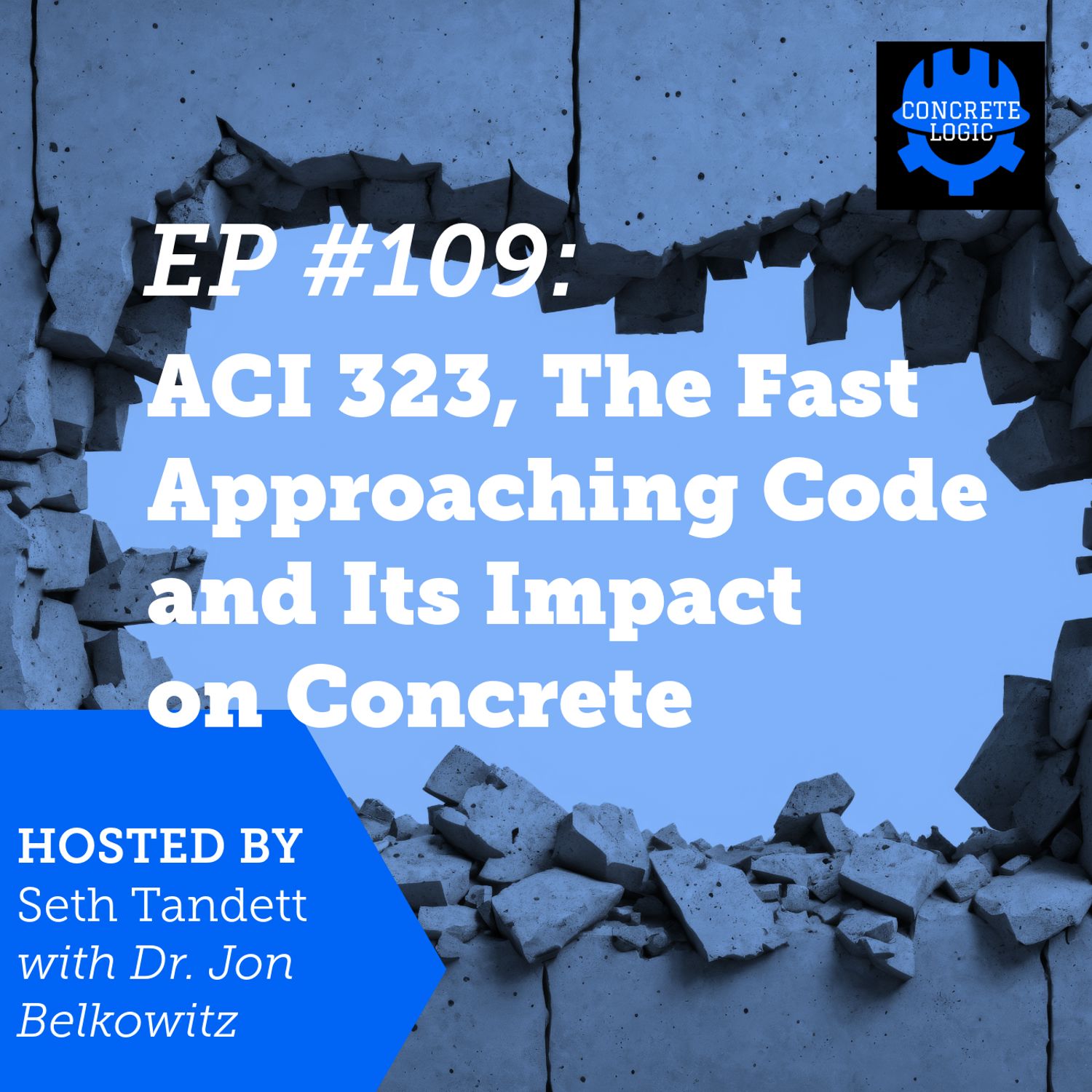EP #139: Concrete Reality Check - INDOT Calls Out the Cement Industry
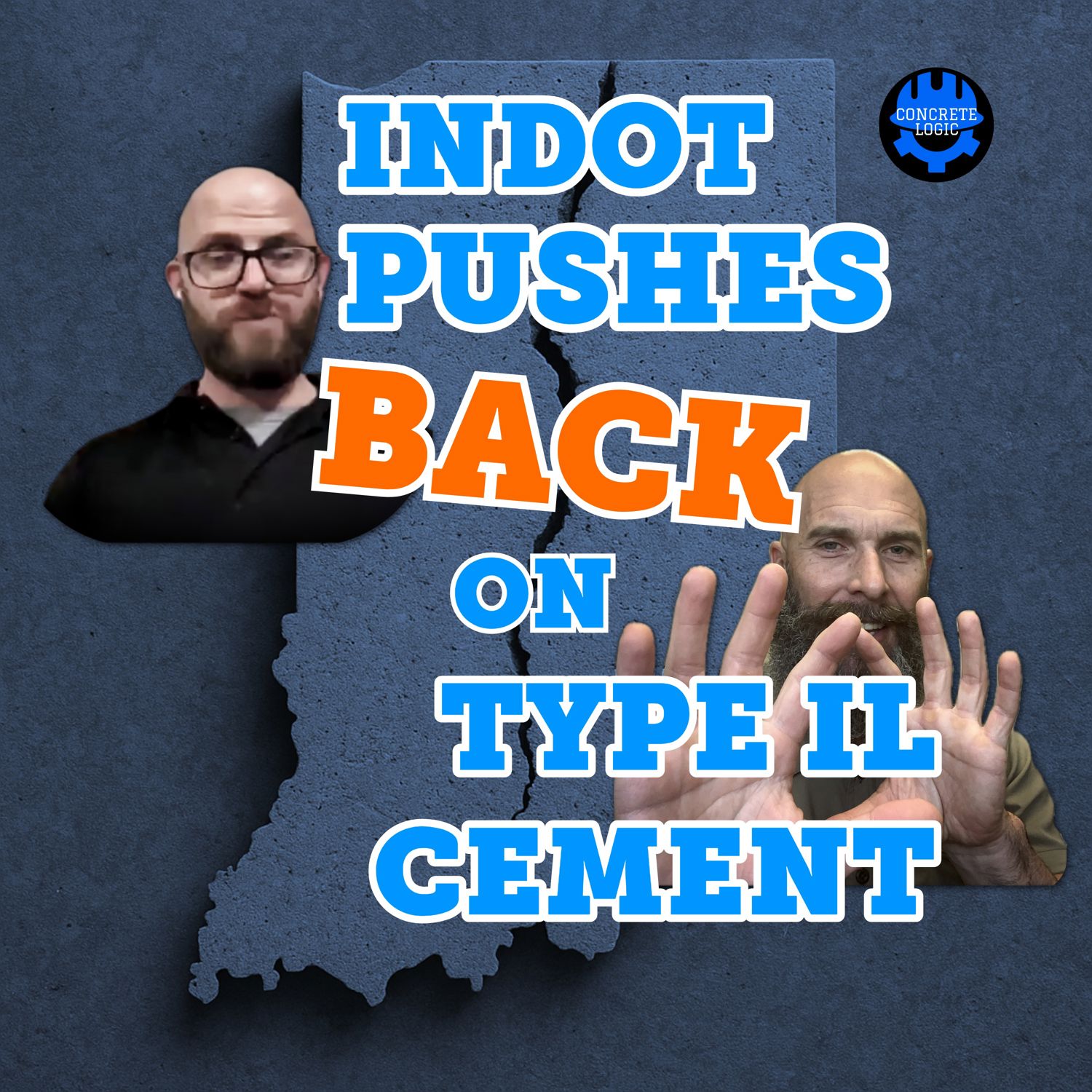
Indiana just told the cement industry it won’t accept any blended cement with more than 10% limestone.
That’s a first - and it’s not sitting well with the people who pushed Type IL cement in the first place.
For the first time, a state DOT pushed back on Type IL cement—and the industry fired back. Indiana’s Department of Transportation says it’s protecting performance after bridge decks started scaling. The American Cement Association says the DOT’s new limits are unnecessary, confusing, and unscientific. So, who’s right—and what does it mean for the rest of the country’s concrete?
What You’ll Learn
• Why INDOT limited Type IL limestone content to 10%
• The ACA’s objections — and what’s left unsaid
• How PCA’s 2021 carbon-neutrality roadmap and the federal Buy Clean program accelerated the switch to Type IL
• Why the “one-to-one replacement” claim may have been oversold
• How variable limestone content (≈7.6–12.4%) affects consistency and performance
• Why admixtures and curing aren’t substitutes for good practice
• What INDOT’s maintenance and inspection programs get right
• Why other DOTs may follow Indiana’s lead next
Chapters
00:00 – Introduction & ACA Briefing Overview
01:00 – INDOT’s 10% Limit and Industry Response
04:00 – How Type IL Cement Took Over the Market
07:30 – PCA Roadmap & Federal Buy Clean Pressure
10:30 – Complacency and the One-to-One Myth
14:00 – What Really Drove the 2021–2023 Flip
18:00 – Cement Chemistry and QC in the Field
22:00 – The Variability Problem: 7.6% vs 12.4% Limestone
26:30 – Are Admixtures and Curing the Real Culprits?
30:00 – INDOT’s Data-Driven Maintenance Approach
32:00 – Why Other States Are Watching Closely
Guest Info
Dr. Jon Belkowitz – Chief Technical Officer, Intelligent Concrete
Email: jon@intelligent-concrete.com
Website: https://www.intelligent-concrete.com
Concrete Logic Academy
Earn your PDHs the logical way.
Explore practical courses made for contractors, engineers, and producers.
Free trial: https://www.concretelogicacademy.com
Support the Podcast
Support the show and be listed as a Producer for life on the episode page:
https://www.concretelogicpodcast.com/support
Media & Sponsorship Inquiries: seth@concretelogicpodcast.com
Podcast Partners
Intelligent Concrete
At Intelligent Concrete, we combine lab precision with field expertise to help you understand what your concrete is telling you. Our services include mix troubleshooting, forensic and petrographic testing, performance-based specification and admixture development, and training for engineers, contractors, and producers. Whether you’re chasing consistency, durability, or answers after a failure, Intelligent Concrete delivers the data and insight to solve problems and improve performance.
Learn more: https://www.concretelogicpodcast.com/intelligent-concrete
KUIU (Affiliate Link) – https://www.concretelogicpodcast.com/kuiu
15% off the first order.
Credits
Produced by Jodi Tandett & Concrete Logic Media
Music by Mike Dunton — https://www.mdunton.com
Connectivity
Host: Seth Tandett
Concrete Visionary | Business Development at Baker Construction | Host of the #1 Concrete Podcast
LinkedIn: https://www.linkedin.com/in/sethtandett/
YouTube: https://www.youtube.com/@concretelogicpodcast
Website: https://www.concretelogicpodcast.com
If you learned something new, share this episode with your team and help more engineers and builders think logically about concrete.
Until next time, let’s keep it concrete!
Reference Links
- ACA Briefing: “Portland-Limestone Cement Limits in Indiana Department of Transportation Specifications” (October 2025 Update) — https://tinyurl.com/TypeIL
- INDOT Recurring Special Provision 901-M-069 (Effective December 1, 2025): https://www.in.gov/dot/div/contracts/standards/rsp/sep25/900/901-M-069%20251201.pdf
- INDOT Testing Memos Referenced in ACA Briefing:
• 21-05 • 22-02 • 23-01 • 24-03 • 25-02 (Available at https://www.in.gov/indot/doing-business-with-indot/contractorsconstruction/division-of-materials-and-tests/current-testing-memos/)
30:44 - – INDOT’s Data-Driven Maintenance Approach
Dr Jon (00:00)
on peter
Seth Tandett (00:02)
And welcome to another episode of the Concrete Logic Podcast. And today I have Dr. Jon Belkowitz with Intelligent Concrete. ⁓ And ⁓ we wanted to talk about a briefing from the American Cement Association.
Dr Jon (00:10)
Adio!
Seth Tandett (00:19)
October 2025 update.
Dr Jon (00:20)
Was it October? I thought it was September. October, you're right, you're right, you're right. Sorry, sorry, sorry.
Seth Tandett (00:23)
No, it's it's octa it has an
update and might have came out in September, but it is it was called Portland limestone cement limits and Indiana Department of Transportation specifications. And I'm just going to read this first part here, Dr. Jon. ⁓ OK, in May 2025 in response to recent concrete bridge deck.
Dr Jon (00:41)
I'm listening buddy, go ahead.
Seth Tandett (00:48)
defects the Indiana Department of Transportation Also known as in dot issued a recurring special provision to limit the limestone content of type 1l cement Also known as Portland limestone cement which I know you enjoyed dr. Jon to a maximum of 10 % by mass the recurring No, no, let me finish you can't interrupt
Dr Jon (01:08)
Time the F out. Hold on a second. No, no, no. I got
no problem with type 1L cement. What I have a problem with is complacency. Go on.
Seth Tandett (01:15)
No no no no.
I just did the no no no.
Yeah. I thought I heard you. don't like Portland limestone cement. PLC. The that. The. Okay.
Dr Jon (01:26)
That's not what it is. It is a
blended cement. It's not a PLC. Go ahead.
Seth Tandett (01:30)
Okay,
but anyways, recurring special provision is effective for projects lit on or after September 1st, 2025. Representatives of the cement and concrete industry note that it disregards the specifications developed by committees of professionals at the American Association of State Highway and Transportation Officials and ASTM standards.
Dr Jon (01:55)
Oof.
Seth Tandett (01:56)
organizations. Needlessly complicates and generates confusion through conflicting requirements. then lastly prevents manufacturers from effectively optimizing for best materials performance. The American Concrete Pavement Association, the National Ready Mixed Concrete Association, and the American Submit Association oppose the
recurring special provision and are pursuing a collaborative approach to address NDOT's concerns.
Let's see, let's see. On June 19th, 2025, the group sent a joint letter to NDOT to request that implementation of the recurring special provision or RSP be delayed until a comprehensive root cause analysis can be completed. The following points were raised with NDOT. Limestone content of type 1L cement has no correlation to scaling resistance.
The entire concrete system must be evaluated. Add mixtures are not a substitute for sound construction practices. Frequent specification changes obscure performance evaluation. Experience in adjacent states contradicts in-dot experience. So.
Dr Jon (03:09)
Wow.
Oof. Oof. There it goes on. I just want to talk about that first part, which thank you for not sharing the document that I sent out, because I'm not ready for that.
Seth Tandett (03:10)
And then it goes on.
Right.
Dr Jon (03:22)
yet. I'm just looking for an ASTM. But what are your thoughts, What are your initial thoughts when you read this?
Seth Tandett (03:28)
Through very previous podcasts, we, I think we've warned folks that there could be potential issues with type 1L cement, just re and not just based on people coming on here and being anecdotal, I guess. I mean, if you go back to, I think I did episode 126 where we went back and just reviewed the state of art.
Dr Jon (03:37)
Mmm.
Seth Tandett (03:54)
the state of art report. ⁓ State of the art report, thank you. That we were just going through and reading the, that report is referenced a lot when the American Submit Association sends out whatever papers, there's a lot of papers they reference, but that was the one that I saw a lot, so just.
Dr Jon (03:55)
Sure, state of the art.
Yeah.
Seth Tandett (04:17)
walking through that. But anyways, going back to that, there's definitely warnings in that paper that say, these are potential issues that you can have with type 1L cement. So it was, one hand, good to recognize that there could be potential issues. So I'm not surprised that this is happening. Just due to, well, let me finish. I think I pointed out the rapid
Dr Jon (04:35)
Well, in that-
Sorry, sorry, go ahead.
Seth Tandett (04:43)
rise of type 1L cement. if you go back to late 2021, we were floating between in the United States, the use of type 1L cement was between 10 to 12 % of all projects across the United States were using type 1L cement. And we jumped up to over 60 % within four years.
Dr Jon (05:01)
Wow.
⁓
Seth Tandett (05:10)
So that's a rapid change of concrete chemistry in a short amount of time.
Dr Jon (05:18)
we ever done that before?
Seth Tandett (05:19)
I don't
know, but that just, you know, my view of that, that's a rapid change for an industry that doesn't change very quickly. I mean, we always make fun of each other. know, the older guys saying, hey, we've been doing it the same way for 20, 25 years, and here we are, we're changing, 30 years. We can say 30 years now.
Dr Jon (05:31)
Make change.
FOOF!
30 years.
Seth Tandett (05:47)
here we are, we're changing something and, and, and, and about four years. So yeah, we're going to have problems.
Dr Jon (05:52)
Like what
do you even, any other industries, any other, maybe the movie industry? We went to CDs pretty darn quick.
Seth Tandett (05:59)
Yeah, as far as technology, Because that's what this is. It's a change in technology, right?
Dr Jon (06:02)
Yeah, transfer.
This is not CDs
or iPods. No, this is cement concrete. okay, so other industries can make this change because the decisions that they make don't last generations. Like if I choose CDs versus iPods, like I'm not going to damage an infrastructure and cripple, you know, the funding of an entire state or region.
Seth Tandett (06:26)
Mm Yeah.
Dr Jon (06:28)
I'm not saying
that that's what, hey look, new concrete that's magnetic. I'm not saying that's what's happening here, but it seems like it's pretty effing close. It's not that it's a small businesses that we went from 12 % to 60. That can't be right.
Seth Tandett (06:32)
That's cool.
Yeah. ⁓
Dr Jon (06:47)
in four years.
Seth Tandett (06:49)
It's in that, if you look it up, if you go back to that episode, um, one 20, and then I can say, yeah, I can send you the, my copy of the report, but it's in there. There's a graphs, you know, you love graphs. There's a graph in there. There's a graph in there. It shows you, you know, we're plotting along, you know, about 10, between 10 and 15 % for, you know, ever. And then all of a sudden, boom, 2021 comes in.
Dr Jon (06:53)
I need to read the state of the art report.
Right.
You've got to ask yourself, because it wasn't 2021 where it started. And, you know, can you show that graph?
Seth Tandett (07:23)
yeah, but you keep talking. I'll look it up.
Dr Jon (07:24)
And what I mean by that, I'm not saying it,
so it's that for that rise in 2021 to happen, the work started in like 2019 of starting to go to conventions, starting to speak to ready mix providers, introducing this new material. And I mean, case in point, Rich was one of the first ones to get type one L cement in 2019.
And 2021, it went, growing from the coasts inland, or excuse me, 2009, it started growing from the coasts inland. And I remember being at this Utah Ready Mix Concrete Association. We're having hors d'oeuvres or, you know, dessert after lunch. And there's this tall cement guy. Never forget how tall he was. I had to look up to talk to him. And he wasn't even looking at me. He was looking like over the crowd. And I asked him like, hey.
You guys are really leaning into this one to one argument, huh? He goes, yeah. I'm like, so what you're saying is this new cement is a one to one replacement for hardened and fresh and everything durability to your C150 or Portland, but yeah. Yeah. I'm like, come on, man. Really? Really, really? And I know that's not scientific. I'm the material science guy.
But again, any other industry, like again, I go back to the Coca-Cola reference. I remember when we went from old Coke to new Coke, like, geez Pete, there was riots in the street. All right, let's see this. Okay, so.
Seth Tandett (08:52)
Yeah. Yeah, that's a good analogy. was
thinking about it. So I was wrong. It was below 10%. So if you look at this graph, Dr. Jon, it says blended cement share of total US cement consumption. And then if you scroll above it, ⁓ right here.
⁓ So type, ⁓ where does it say here? Type, the ternary blends, the strong uptick in blended cement production is a result of increased consumption of PLC or type 1L more than other cements with the USGS estimate that more than 95 % of the US blended cement is PSL.
Dr Jon (09:18)
Yeah, the ternary blends, Type 1L.
Seth Tandett (09:37)
And so this is the use.
per US geological survey data on consumption of blended cement from January 2020 to July 2023.
Dr Jon (09:49)
So, and we're not gonna do this, but it's not just the data that I find interesting. ⁓ What I find interesting is the growth in the data, because you have this, and it's an ugly hockey stick, but you've got a hockey stick. It's more like a goalie stick type curve here, right? And then if we look at certain areas, we have plateaus.
And we have peaks. we ignore all of those and just look at the first major peak, November, January, between Thanksgiving and Valentine's Day of 2021 to 2022. Where were you?
Seth Tandett (10:32)
Where was I? I was in Virginia. Yeah, I was on some major projects.
Dr Jon (10:32)
We were still in Colorado at the time. Yeah. They know exactly where I was.
You some major, major projects, right? ⁓ You know, if you're not new to the United States, November to January and February, most of the U.S., except for if you're in the southern part of the U.S., is done. You know, we take a break at the end of ⁓ October. Normally, you know, we start shutting down around the end of, or after Halloween, it really kicks off.
Seth Tandett (10:42)
Yeah.
Dr Jon (11:08)
Thanksgiving, some of us might come back to work, but once Christmas hits, we're out of a goucher through New Year's, even all the way through Valentine's Day. That's not the majority, but that's a large portion of the U.S. And I'm talking residential construction, right? I'm not talking low-end, high-end commercial or coastal construction, especially in the Southern States. Does that make sense, Seth? Right? So.
Seth Tandett (11:32)
Yeah, lines up.
Dr Jon (11:34)
Now granted, this stuff that was over here, the consumption, this is cement being sold. So it's being sold for use. So what was sold in November to February was probably used the following quarter. Is that a fair assessment?
Seth Tandett (11:52)
Yeah, there's
a, there's going be a lag there. Yeah.
Dr Jon (11:54)
There's going to be a lag. Thank you. couldn't think of the F word. So we're really talking about it again, what you and I were talking about. There's work that has to be done ahead of time the year two before to really get people cracking on this. So here's where you have that, that work of people pushing it into the market in the early 2000 or 2020s, going all the way through the late 2021. Now what, as much as it took to get here,
What in the hell do you think happened in 2020, the end of 2020, right? 2021 that caused that peak in 2022 and it just to take the F off. Because not just, it grew to 60%. Why did it grow to 60 % in less than two years?
Seth Tandett (12:46)
That's when all those plants flipped over to type 1L, the cement plants.
Dr Jon (12:52)
Um, I thought that was August 23rd, 2024. Can we, can we do a chat GPT on that real quick?
Seth Tandett (13:00)
Yeah.
Dr Jon (13:01)
Okay, don't get upset. I like chat GPT to get us started.
Seth Tandett (13:04)
OK, well, I just didn't expect that. ⁓
Dr Jon (13:08)
Why did well? mean, hey, you use chat GPT and I'll use Google Scholar. How's that? We'll see what we can get.
Seth Tandett (13:13)
Okay. I thought you were going
to angry grok.
Dr Jon (13:17)
What's an angry rock? What's an angry...
Seth Tandett (13:17)
And so what are we at? We're asking
it. When did all the cement?
Dr Jon (13:22)
Why did, I'll try to upload that paper and say ask why was there, what caused the major increase in blended cement consumption for concrete in the US at this time period.
Change over to blended, what year was it? November 2021 to 2023 in the US concrete industry. Isn't that what I just asked? And folks, I got nothing wrong with using ChatGPT to help your research go faster or to help clean up a sentence.
It's when you no longer use it as a tool, but it's doing the work for you that you should be embarrassed.
I mean, even chat GPT is going to get things wrong. Breaking barriers to low carbon concrete pavements. I can't wait to read this crap.
Seth Tandett (14:14)
Do you want me to read what I got?
Dr Jon (14:15)
That was 2024.
Yeah, yeah, please, please.
Seth Tandett (14:19)
All right, I'll just read the first thing that they.
Dr Jon (14:22)
Right, yeah that's the problem.
Seth Tandett (14:24)
It says in late 2021 and early 2022, the Portland Cement Association publicly committed to its roadmap to carbon neutrality by 2050. PCA told member producers, by the way, PCA is ACA now. We used to be Portland. Yeah. PCA told member producers to accelerate the switch to Portland limestone cement as the easiest way to claim a 10 % CO2 reduction.
Dr Jon (14:39)
Portland Cement to America Cement.
Seth Tandett (14:50)
The EPA, DOE, and GSA followed suit pushing low carbon materials and procurement specs in federal projects, which was the Buy Clean initiative. ⁓ Overnight, PLC became the default cement for DOTs on public bids.
Dr Jon (15:11)
Yeah, and does say anything about ACI?
Seth Tandett (15:14)
No, it starts talking about supply chain.
Dr Jon (15:17)
There was also a big push. There was a big push from all the associations, ACA, PCA, whatever you want to call it, ACI. There was a huge push. Everybody got together at a table, shook hands, signed with fricking national president. So, and it was right around this timeframe.
Seth Tandett (15:25)
Yeah.
Dr Jon (15:35)
This is in mathematics. How do you describe this curve? It's a positively increasing gradient around that November 21st. And then it turns into a constantly increasing gradient. Then it slows down to a plateau. And then goes back to positively increasing constant, plateau, plasidate. Then there's a spike. Then there's a drop off.
Seth Tandett (15:36)
Yeah.
Dr Jon (16:02)
Yeah, you know, the funny thing would be is why do you see these spikes in these drop-offs?
And I'd love to get Rick's ⁓ interpretation of the spikes and then the drop-offs, the spike and the drop-off. Is it rebates? Is it failures? Is it we've got to make the cement differently?
Because if anything, anytime you have a peak and a drop off, it's such a high percentage.
Seth Tandett (16:25)
Something's going on.
Dr Jon (16:25)
I mean,
yeah, all of this tells me something. This flat, this plateau, and this peak, and this drop off. So I'm more interested in...
Seth Tandett (16:30)
Well, that, yeah that-
Well, you know, this was the time too where we were, know, 2020, we were we were all shut down. So what I was hearing in the field was I can remember. Yeah, I'm fairly certain it was going on in 2022 too was. ⁓
Dr Jon (16:33)
You couldn't...
Seth Tandett (16:51)
They couldn't keep up with demand. So there was a supply chain crunch going on and there was an increase, you know, then, and there was also price increases. So there could have been some demand.
softening because of the I mean the the price increases during this time were insane
That would be my, I would have, yeah.
Dr Jon (17:10)
and they're only gonna get worse so...
My argument about what you read, and thank you for reading that. I don't have the patience to do what you did. The three bullet items that you shared that the ACA presented disregard the specifications, needlessly complicates and generates confusion, prevents effectively optimizing material performance. I'm, what's called? This is not verbata. I'm paraphrasing.
Couldn't that same argument be made for the one-to-one replacement? That was my original question. What the Indiana DOT is requiring, could that be argued, their argument about what Indiana DOT is doing could be argued about the one-to-one replacement? Sale pitch.
Seth Tandett (17:58)
Yeah, yeah, you could.
Dr Jon (18:00)
I gotta hold on to you, okay?
Seth Tandett (18:01)
Yeah, go ahead.
Dr Jon (18:02)
Sorry.
Seth Tandett (18:03)
No worries.
Dr Jon (18:04)
I think we... Can you hear me?
I think what you're going to see in that same chart of yours is a positively or a negatively decreasing
from 2025 on when they updated. Or maybe like a drop-off and then a plateau. I mean there's just a lot of people who are going overseas now. And then you have Ozinga or sorry other companies who are starting to buy clinker from other folks and produce the C-150 cements that we're used to.
Seth Tandett (18:33)
Is that, okay. I won't. Yeah. I know what you're saying. Yeah. Well, this document, the briefing here, the ACA briefing, I mean, they're not saying stop using type 1L cement. They're just saying they want to keep it 10 % or lower. So I don't think it's going to be a reverse of this curve, right? It's going to be maybe a little bit of a
decrease because all the all the big dogs in the ACA are all type 1l plants.
Dr Jon (19:02)
Is that true? Do you know that for a fact? Yeah, I don't think that's true. I think you might be able to say that about the ACA. I don't think that's 100 % true. not a... Yeah, I never say definitive, but the better question is ready-mix plants. And which ones are starting to gravitate. And again, I...
Seth Tandett (19:04)
I believe that.
You
Dr Jon (19:21)
I agree with what you said. I don't know if you said this, but I don't think changing from 10 % to 8 % or 12 % to 10%, I don't know if that's gonna make much of a difference personally. If you still have complacency, if you go from 12 % to 10%, maybe you go from 12 % to 3%. Like if you don't, all good concrete practices dictate that you do a dial-in process.
Right, and one reason why I love the Quivis plant is we had a lab over here where we can do one to six cubic foot batches, tested anything that we wanted to. You had quality control shacks all over the freaking place, and then you had this gorgeous plant. And we could bring the trucks over to the freaking, or the laboratory, or to the quality control shack. And there was like a heater and a microwave in the quality, and a refrigerator. It was awesome.
Seth Tandett (20:15)
Mm-hmm.
Dr Jon (20:16)
I mean there are concrete companies who do that, they do that nowadays. Why can I sound like I'm retiring? But that's the first thing that goes when people try to save money. It's not just quality control, not just quality assurance, but I mean it's more than that. It's marrying your mixes. Concrete production, the great Kevin McDonald. Have you ever seen Kevin McDonald's presentations?
Seth Tandett (20:42)
I don't believe so.
Dr Jon (20:43)
Kevin MacDonald falls in a long line of amazing concrete teachers, not professors. I like to use the word teacher. I think he was a professor, but he is a true teacher. And one of the things he talks about with concrete mix design is how it relates to, I believe it's a concrete cookie recipe. And if you've never known a professional baker, they know their recipes intimately.
And I like the distinction of connecting cookies that, I mean, cookies mean more to us as concrete does. That's why they started with a C. I mean, there's no coincidence that concrete starts with a C-O and cookie starts with a C-O, and there's a bunch of Ks or Cs or Es in both of them, right?
Seth Tandett (21:25)
Mm-hmm.
Dr Jon (21:26)
I mean,
that's not just a coincidence. And we have to love our concrete recipes as if we were children looking through the window watching the tiny, teeny chocolate chip morsels melt. And know when the cookies puff up and they brown up top, they're almost ready to go. 10 more minutes, five minutes in the oven, five minutes of cooling, and you have a crisp, wonderful cookie, right?
Most of us understand that feeling, that smell in the kitchen, especially when we were kids. We have stopped treating concrete that intimately. It's not just somewhere along the line, somebody convinced the industry that not only that we need performance-based specifications, but we can make performance-based specifications with performance-based materials. It started with aggregate.
It moved over to admixtures, and now we find it not only in our blended supplementary cementitious materials, but also our blended cements. I don't need to tell you what's in this for you to make your performance-based concrete. You imagine telling that to a baker? Don't worry what the flour is, whether it's wheat, bleached, enriched, or tapioca, rice, almond flour. There's an effin difference.
Seth Tandett (22:38)
Mm-hmm.
Dr Jon (22:38)
between those,
you can't just say don't worry, trust me, I don't know why I'm doing this. We need to know ⁓ what's in our cement. And I refer back to the great Peter Taylor who wrote Concrete Curing, I believe it's page 1929, where he goes over the change in cement chemistry and how that impacts the final concrete product.
we used to do that. We used to look at mill reports, especially when shit went wrong. And then when that didn't work, we used to get an updated mill report or we used to send it to CTL group or somebody like, you know, WJE, hey, give me this mill report real quick. And then we would do some type of semiglutamate calorimetry in the shop to see what chemical signature had changed. And we compared it to old ones. That's not an aligned item budget for any of the ready mix providers out there.
Sleeping in your in your plant costs a lot of fucking money So I don't blame the ready mix providers to a certain degree when they said hey We were sold a one-to-one great, but now you still have to take the responsibility of good concrete practices so just like Just like the one-to-one I this is the only thing I think I agree with is that I I don't know if changing it from
You're allowed to go up to 12 or 13%, which is what they're doing. They're not at 10 % with a lot of these type 1L cements. They're not 10 % limestone. They're normally 12.4. And there is a difference. I mean, we used to only have 3%. Now you're dropping between 10 % and the same amount that we used to allow in cement.
Like that fluctuation and then the cement gets caught up in the silos. Like, why do we have to tell you this? Don't y'all know this? Doesn't the ACA know that? That is what they're trying to do is just close the barn door. Like originally it can jump up to 12.4 and it can go all the way down to what is the number? 7.6, 8.6? Whatever 10 minus 2.4 is, 7.6, right?
Like that's, then normally they're gonna go up to 12.4 because that's where they're making their, KESAP, their money. Right? And that makes sense. You you sell more limestone, you have a greater carbon reduction, right? And you're also making more money too. Limestone dust is what? Yeah, it's $10 a ton.
Seth Tandett (24:49)
Les.
Dr Jon (24:52)
Then somebody asked me, I don't want to say his name, what do you think they're their limestone finds from, Jon? I'm like, I don't know, I didn't even ask. He goes, they're not getting it from the precious limestone deposits, they're getting it from those piles that have grass growing out of it.
I don't want to believe that. I really, really don't. That is terrible. I have a lot more faith in the cement industry. just so the ACA understands, if they didn't even think about it, this is the thing. People don't think about the freaking math. Why are they asking you to go from the possibility of jumping all the way up to 12.4 to, hey man, if you're going to say 10, stay at 10.
Seth Tandett (25:09)
you
Yeah. I mean, that's talking about math and how much you like math. I, am I looking at it right? That's a 20, 24 % increase.
Dr Jon (25:34)
Thanks
Yeah, something like that. Yeah, that's like what...
Seth Tandett (25:42)
Yeah. They're like,
oh, it's only 2%. It's only 2.4%. But really, it's lot.
Dr Jon (25:49)
Fair, yeah. mean
that... Go ahead, I'm sorry.
Seth Tandett (25:53)
I
was just saying, you're just looking at 10 % and you're allowed that leeway and amount of limestone in it, it's a big difference.
Dr Jon (26:02)
play with the charts, it's called Reagan economics. You play with the charts to make it look as good as you want it to. A lot of industries have used it. don't worry, this small change is not going to affect you much. It costs a lot of money to maintain
any performance in concrete consistently with any effing change. That's why when you look at ASTMC 94, they only allow 2.4 percent change, right? But that's with weights of material when we talk about additions to a cubic yard. Now if you go outside of those, you can't sell the concrete.
Again, we're actually not going up 2.4 % and we're not going up. Our deviation can be 20%. So we can go up or down. More than likely, they're going to go up, even though they're telling us we're at 10, we're at 12.4. It's a different type of cement. I think that's your argument. I don't think there's any other industry that allows that. Like Coca-Cola. Take out 22 % of the syrup.
Seth Tandett (27:04)
Yeah.
Dr Jon (27:11)
And what do you have? RC Cola. It's not Coca Cola. It tastes totally effing different. Is that a fair assessment?
Seth Tandett (27:18)
I guess I did not know that that's why it's RC Cola.
Dr Jon (27:22)
was just making that up. You got coffee in the morning. If you take out almost 25 % of the sugar or coffee, is it going to taste different? No, it's not. No, it's not. Because I'm going to put something in there with my filler to capture some of that performance that you like. It's not sugar. Don't worry what it is, but I'm going to get you that performance back.
Seth Tandett (27:24)
Ha ha ha ha!
yeah.
Why not.
⁓
Dr Jon (27:47)
That's what Indiana is arguing. Can I please close the barn door? Can I please close that gap? And what I'm doing now is I'm allowing my local industry, for some reason, is my local industry being complacent? my ready make... Whatever it is, they can't deal with this big barn door. And I've given them the opportunity.
Now if they're not going to do it, this is the first thing that I'm going to do to try solve this problem. And what are some of the things that they say in here? Needlessly complicates? Like I don't think that's fair. I, you know, I know the people who did this work and there was no needlessly, there was no generalizing confusion.
It was all about making a better concrete for the state of Indiana. And now the recovery effort is the same thing.
Seth Tandett (28:34)
I mean, one could argue specs change from job to job, so.
Dr Jon (28:35)
Harsh words.
The specs don't change often in the DOT though. And that inherently becomes the problem. I remember I was working with the New Mexico DOT a decade and a half ago and we were introducing colloidal silica to them. And we can't use it. They're like, what do mean you can't use it? Why can't you use it? You haven't even tried it out yet. Well, it's not in the spec. So why does that matter?
the material that you have in the spec is no longer in your state. Like you want fly ash, but all your fly ash is going to California. Like, I don't understand. The material you have is not in the spec. This material, which is abundant and it solves your problem based on a copious amount of research.
because it's not in the spec. So that's the funny thing. And I asked ChatGPT that question, because this is a philosophical question that we don't have time. And I asked ChatGPT to create a description of the job of a state civil engineer and their role to use the ASTMs, AASHTOs, and other standards as a starting point.
for designing for the people with the funding they have. And holy shit, did it give me a schtick and a spiel. So I didn't read this yet, I'm just gonna read this in short. So it gave me a page of shit, but now it gives me a conclusion. State civil engineers use standards as a starting point, not as a finish line. They interpret ASTM and ASTRO through the lens of people performance and practical funding. Their work is where...
Policy meets pavement. And where design becomes service to the public good. All right, chat, GPT, calm down. Calm down. Less aggressive adjectives. That's why I can't stand it. Somebody sent me a paper. like, oh, I worked really hard on this. And the team worked really hard on this. And I read the paper. And you had all those EM dashes, those long, weird dashes, circular arguments. I was like, dude!
Seth Tandett (30:22)
Mm.
Dr Jon (30:30)
at clean those things out of chat GPT or your finished work. that is the job of a state engineer, not to use the standards as, well, I don't know what to tell you. You said it best, Seth. How did you just say it? Specifications.
Seth Tandett (30:44)
changed
from job to job.
Dr Jon (30:46)
Yes, that's what it's supposed to be if you're worth your weight as an engineer. And I guess this is the first time that the ACA has dealt with an engineer that gives a shit about their concrete. And I shouldn't say one, it's a lot of engineers in Indiana who care about what comes out of that chute and what is placed.
Seth Tandett (31:02)
I'm sure all the DOTs are paying attention to this.
Dr Jon (31:05)
I hope they pay, and I've been saying this for years, before Indiana had to deal with this Michigas, they already had a very good maintenance program. Indiana not only has a fair amount of freezing and thawing cycles, but it's also got a lot of wetting and drying cycles. It's why it's the agricultural belt. It dries, or it rains and then it dries, it rains and then it dries, it rains and then it dries, so on and so forth, right? And water gets displaced, then it dries, water gets displaced and it dries.
So they already had, years ago I started bragging about, and if you look back on some of your older blah blah blahs that we did, I was bragging about their maintenance program. Every 10 years they evaluate, if it's in deterred they mill the surface, they add an overlay. At 20 years they mill the surface, they add a polymeric overlay. I mean they have a very good inspection program too that's given by the feds.
Like, I mean, they do a good job of not just putting concrete down, but evaluating it and maintaining it. And I would constantly say other states need to look at their quality management program because it is, it is, I hate it when they call it quality management. I liked the idea of preventative maintenance because holy shit is their concrete good. Especially if you drive from Chicago or Ohio over to Indiana.
You'll see the difference right away as you cross into the state. It's amazing. Anyway, yeah.
Seth Tandett (32:30)
Yeah.
Dr Jon (32:31)
So my point, just to wrap this up, because I can hear that tone in your voice.
I thought this was, I thought these first top three bullets...
It disregards the amount of work that actually went into Indiana that precluded this. You know, before we ever had Type 1L. Shit, 2019 to 2021, some of the best concrete was made in the state of Indiana. Some tough words there. Unnecessary and I think it's just deflecting because that same language can be used for the one-to-one argument.
Seth Tandett (32:59)
Yeah. Well, like I said, like I said, it definitely, hopefully this gets this on everybody's radar and we're all paying attention and.
think that was kind of part of the problem that we didn't know this was happening out there.
Dr Jon (33:11)
We got too lazy. The ready mix industry, we were spoiled with fairly good rock in 2019. And the cements at that point were a maze craze. My favorite, favorite, favorite cement is Sugar Creek Cement from Independence, Missouri.
Seth Tandett (33:13)
Yeah.
there. Shout out.
Dr Jon (33:29)
or the alpena
cement like the alpena cement and then there was this magic sand from Wichita Falls, Texas. Where's Wichita Falls? Not Wichita Falls. I can't remember where that magic sand was from. I gotta go figure that out. Anyway, materials have changed. Our industry needs to.
Seth Tandett (33:44)
Yep. I think that's a good way to end today's episode. I will share how to get a hold of Dr. Jon. You want to reach out and talk him about this? I'm sure he'd be happy to. And until next time, let's keep it concrete.

Dr. Jon Belkowitz
Jon Belkowitz is the CEO of EDYSTON, LLC and CTO at Intelligent Concrete, LLC. Before Intelligent Concrete, LLC, he served in the United States Air Force from 1996 to 2006 specializing in Civil Engineering. His tour of duty introduced Dr. Belkowitz to a wide variety of concrete types and uses which were dependent upon the engineering practices of different host nation forces, developing nations, and disaster repair initiatives. Jon has worked in private laboratories on structural engineering and materials development projects to include the application of nanotechnology in concrete. Dr. Belkowitz has worked as a consultant on projects in the United States, India, Turkey, Africa, Italy, New Zealand, Australia, and Germany. Jon has worked as Chief of Materials for a 3D concrete printing firm, an advisor for NASA on 3D printing of concrete holds patent applications on 3D printing with concrete, and is an ACI member on the subject. Jon received his Masters of Mat Science from the University of Denver and his Ph.D. in Mechanical Engineering with a specialty in Nanotechnology in Concrete at Stevens Institute of Technology in New Jersey. Jon is a licensed Professional Engineer in Colorado and Maryland.












